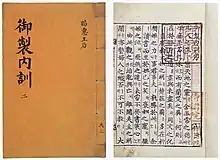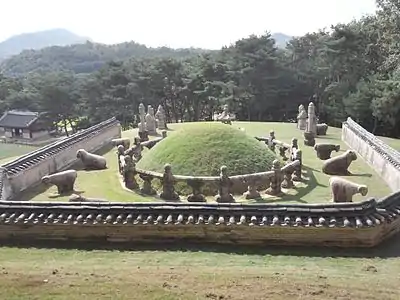Naehun
Naehun (Instructions for women, 내훈, 內訓) is the first known book written by a woman in Korea. It is written as a Confucian guidebook for women. The book is one of the most representative books which reflects social construction of gender and sexuality based on Confucian ideals in premodern East Asia.[1] It has a modern value in that it becomes a unique Korean history material with various Korean royal court vocabulary describing appropriate behavior for a woman in accordance with Confucian cultures.[2]
 First book written by a woman in hangul, 1475 National Treasure of South Korea | |
| Author | Grand Queen Dowager Insu 7 October 1437 – 11 May 1504 (Cheongju Han clan) |
|---|---|
| Country | Korea, Joseon period |
| Language | Korean, Chinese |
| Genre | Morality handbook |
Publication date | 1475 |
| Media type | Book |
Background
Grand Queen Dowager Insu (posthumous Queen Sohye, 7 October 1437 – 11 May 1504) regretted that there were no educational books that women could read easily at that time, and she wrote this book by extracting the key points of the women's discipline from four books of Chinese classical books for women such as Biographies of Exemplary Women , lesser learning, Mingxin baojian , Chinese Introduction for women.
Introduction of Royal Consorts
This is an instruction book for women published in 1475 (year 6 of Seongjong) written by Grand Queen Dowager Insu, the wife of king Deokjong (1438 – 2 September 1457), Korean: 의경세자). Queen Insu was a member of Cheongju Han clan family, appointed as the queen mother in 1475.[2] The most emphasized of the virtue of women in the Naehun is Intellectual, moral rectitude and capability to act as a counselors and to remonstrators to their men. Such portrayal of women suggest a subversive notion of a 'blurred' demarcation of the inner and outer sphere, private or domestic.[3] To justify those understanding, the book states for King and Queen, Men and Women's 'Speech and Component', Sitting, Eating, Walking, Conversation and so on.
Confucian morality for women
Naehun is the oldest known surviving work by a woman writer in Korea, however, it shows the effects of Confucian social values on women's status of the Joseon kingdom. It is published several times at different times, and the notation, as well as the vocabulary and writing style change well, making it an important resource for the study of Korean medieval languages.[4]
Tomb of Queen Sohye
Gyeongneung (敬陵): Tomb of Deokjong and Queen Sohye.
In a royal tomb in the form of Dongwoni Gangneung, the tomb of the King is on the left and the tomb of the Queen on the right. Nevertheless, in Gyeongneung, the tomb of Queen Sohye is on the left, and the tomb of King Deokjong, or Crown Prince Euigyeong, is on the right. The reason is that Crown Prince Eui-gyeong died at the age of 20 under the status of 'the Crown Prince', but Queen Sohye died at the age of 68 under the status of 'Great Queen Mother'. Regardless of gender, the wife's status was higher than that of the husband, so the wife's grave is placed on the left and the husband's grave is placed on the right. More details at https://blog.naver.com/nice-buddy/221900007138.
The Book
At the head of the book is the Queen's letter of Instruction (내훈) and the list. The book is composed of 3 volumes and 7 chapters.[6]
Volume 1
- 언행, Onhaeng, Speech and Comportment
- 효친, Hyochin,Filial Piety
- 혼례, Hollye, Bond of Marriage
Volume 2
- 부부 夫婦, Bubu, Husband and Wife
Volume 3 : Parents, Mother, Cordiality, Frugality
- 모의 母儀, Moui, Motherly Rectitude
- 돈목 敦睦, Donmok, Cordiality in Sibling Relationships
- 염검 廉儉, Yeomgeom, Integrity and Frugality
Queen Sohye's preface
All persons at birth receive the spirit of Heaven and Earth,
and all are endowed with the virtues of the Five Relations.
There is no difference in the principle of jade and stone.
But yet how is it that orchids and wormwood differ?
It depends on whether or not you have done your best
to fulfill the Way of cultivating yourself.
The civilizing transformation of King Wen of Zhou was enhanced
and broadened by the brightness of his consort Tai Si.
The hegemony enjoyed by King Zhuang of Chu 楚莊王
was largely due to the efforts of his consort Fanji.
Who could do more to serve her king or her husband?
The order and disorder, the rise and fall of a country
are related to the wisdom and ignorance of men,
But are also closely tied to the goodness and badness of women.
Therefore women must be taught.[7] [...]
Sources
- Ko, Dorothy; JaHyun Kim Haboush; Joan R. Piggott; Joan Piggott (2003). Women and Confucian Cultures in Premodern China, Korea, and Japan. University of California Press. ISBN 9780520231382. 250 pages.
- Duncan, John (2015). "The Naehun and the Politics of Gender in Fifteenth-Century Korea". In Young-Key Kim-Renaud (ed.). Creative Women of Korea: The Fifteenth Through the Twentieth Centuries. p. 26-57. doi:10.4324/9781315705378-9 (inactive 19 January 2021). ISBN 9780765639943.CS1 maint: DOI inactive as of January 2021 (link)
- Park, Si Nae (2005). Re-reading Queen Sohye's Naehun (Thesis). University of British Columbia. viii+105 pages.
- "Queen Sohye's Instruction for Women (Queen mother Insu, Seongjong's mother)". Academy of Korean Studies. Retrieved 23 August 2019.
- "Royal Tombs | Cultural Heritage Administration". english.cha.go.kr. Retrieved 12 May 2020.
- Eunkang, Koh (2008). "Is Confucianism Incompatible with Gender Equality in South Korea?". Bulletin of the School of Oriental and African Studies, University of London. Cambridge University Press. 71 (2, Scripture and Modernity: A Tribute to Professor John Wansbrough): 345–362. doi:10.1017/S0041977X08000578. JSTOR 40378774.
References to sources
- Ko 2003, p. 166.
- AKS 2019
- Park 2005.
- Duncan 2015.
- RoyalTombs 2020.
- Park 2005, p. iv.
- Park 2005, p. 91.
